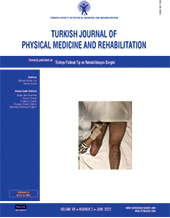Stress level and quality of life of adolescents with idiopathic scoliosis during brace treatment
2 Department of Orthotics and Prosthetics, School of Rehabilitation Sciences, Iran University of Medical Sciences, Tehran, Iran
3 Department of Orthotics and Prosthetics, University of Social Welfare and Rehabilitation Sciences, Tehran, Iran
4 Department of Orthotics and Prosthetics, School of Rehabilitation Sciences, Iran University of Medical Sciences, Tehran, Iran
5 Department of Orthotics and Prosthetics, School of Rehabilitation Sciences, Iran University of Medical Sciences, Tehran, Iran
6 Department of Orthotics and Prosthetics, University of Social Welfare and Rehabilitation Sciences, Tehran, Iran
7 Department of Statistics and Computer, University of Social Welfare and Rehabilitation Sciences, Tehran, Iran
8 Department of Orthotics and Prosthetics, University of Social Welfare and Rehabilitation Sciences, Tehran, Iran DOI : 10.5606/tftrd.2022.8467 Objectives: This study aimed to evaluate the effect of brace treatment on the stress level and quality of life (QoL) of adolescents with idiopathic scoliosis.
Patients and methods: A total of 194 adolescent individuals were evaluated in two groups: the adolescent idiopathic scoliosis (AIS) group with 97 patients (20 males, 77 females; mean age: 13.9±1.8 years; range 10 to 18 years) and the control group with 97 age-and sex-matched participants (20 males, 77 females; mean age: 14.3±1.7 years; range 10 to 18 years) with no spinal deformity. The AIS group wore the Milwaukee brace or a thoracolumbosacral orthosis based on the location of the apical vertebra. All participants of the AIS group filled the Persian versions of the revised Scoliosis Research Society 22-item questionnaire (SRS-22r), the eight-item Bad Sobernheim Stress Questionnaire (BSSQ)-Deformity, and BSSQ-Brace. The control group only answered the first 20 items (subtotal items) of the SRS-22r. The brace-related QoL and stress level were assessed based on sex, brace, and deformity types.
Results: The subtotal score of the SRS-22r in the AIS group was significantly lower than the control group (p<0.001). There was a significant difference between deformity-related stress and brace-related stress (p<0.001). Regarding the type of treatment, there were no significant differences in QoL and stress level between the Milwaukee brace and thoracolumbosacral orthosis groups (p>0.05). Moreover, there was a weak correlation between the BSSQ-Brace and the self-image, mental-health scores, and the total scores of the SRS-22r (r=0.39 to 0.42, p<0.001); the low level of perceived stress was associated with a high level of perceived QoL.
Conclusion: The stress due to brace treatment can decrease function/activity and self-image of adolescents with idiopathic scoliosis.
Keywords : Adolescent idiopathic scoliosis, brace, quality of life, self-image, stress
















